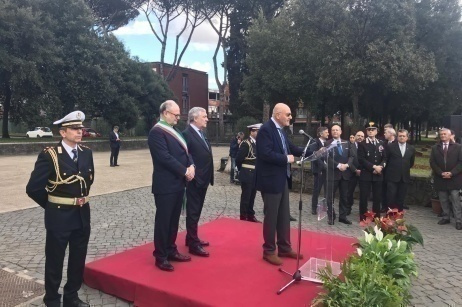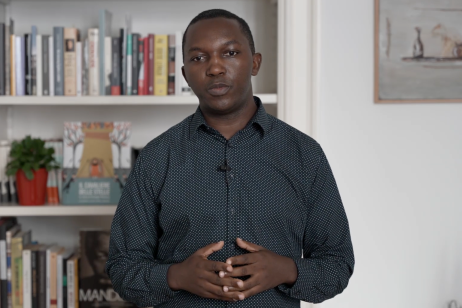
A monument in San Sebastián
“In 2016, when San Sebastián becomes the cultural capital of Europe, we will create a garden of the Righteous, to promote the memory of Good, as an example of dialogue and reconciliation. We want to instil a taste for taking responsibility into our young people.” Mr. Juan Gutierrez, one of the great personalities behind the meeting that gathered the representatives of some European cities destroyed by bombardments during wars, told us members of Gariwo and the Garden of the Righteous of Monte Stella Hill .
The delegates from San Sebastián, the town ravaged by the Anglo-Portuguese troops in 1813, were joined by delegates from Granollers, the city destroyed by Mussolini during the Spanish civil war; the famous Guernika, whose suffering was made immortal by Picasso’s painting; Sarayevo, which was shelled, but not bowed, by the Russian troops; Wroclaw, the Polish town destroyed by the Nazis; the German city of Dresden, which underwent one of the most tragic punishments by the Allies who wished to put down the Nazi force.
Juan Karlos Izazirre from San Sebastián introduced by his speech one problem which is probably the key of the whole conference. Starting over after destruction means two essential things: rebuilding homes and facilities, but also rebuilding people. It is thus possible to “rebuild wrongly” with a victimistic memory, when instead of working out our losses effectively we recreate hatred, not only towards yesterday’s villains, but also towards the neighboring countries. On the contrary the key issue is to teach citizens that what happened to them in a tragic past does not have to repeat itself anywherelse in the world. The moral reconstruction of a destroyed city is fullfilled only when inhabitants grow with a culture of peace and are able to be open to dialogue with others. Otherwise bombs are not going to be deluse anylonger, but remain stuck in the hearts of the following generations, in an endless process.
Begona Landa Torre, representative of Guernika, instead reminded us that during francoist dictatorship it was a taboo to remember Nazi destruction, as this would mean discussing about the responsibilities of fascism. Only in the recent years a discussion has started about that terrible memory. Hence eventually a great moment of positive workout of that past was made possible when a German delegation visited the town in 1997 and symbolically apologized for the murderous bombings made by the German aviation. Admitting guilt and responsibility is thus an indispensabile therapy to defuse a kind of hatred that would otherwise go on mounting over time. Strong of this experience, that enabled its inhabitants to look optimistically to the future, the city of Guernika to our date promoted a prize for peace, meant for those who work for reconciliation between former enemies in the world, and who take responsibility for the past guilts.
The anti-hatred therapy is no easy task, underlined instead Mr. Matthias Neutzer, from Dresden. The memory of a tragic past, unless it is worked out following a universal criterion, runs the risk of being exploited by fanatic groups that use it to demand revenge, as it has recently happened with filoNazi and far right groups, but also with some old communist leaders of the GDR during cold war, who tried to present the shelling of the city under an anti-Western and anti-European light. The meeting was also attended by Aaron Tovish, representative of “Mayors for Peace”, a network of cities created to warn the world’s public opinion about the danger of nuclear weapons. In a private meeting Mr. Tovish told me that the current mayor of Hiroshima is rather unwilling to tell about the losses the city undergone by the Japanese town, together with the destruction that hit other world’s towns with different, yet always lethal, weapons. In fact, when Mr. Tovish told him about the massacres committed by Syria's dictator Assad and invited him to make a solidarity gesture towards the population of Damascus, his request was met with silence.
The reason of this closure was the fear that the memory of other destructions could relegate the suffering of the Japanese on the background. The atomic bomb in that mayor’s feelings was the absolute Evil, that no one should ever compare with other evils. If there had been mixture, said the mayor, the suffering of Hiroshima’s citizens would have been relegated on the background and forgotten. This remark reminded me of a statement made last year by some exponents of Yad Vashem who appeared rather unwilling to remember the Righteous in the Holocaust together with the ones of other genocide cases. “If we ‘mix up things’ – they said – the unique feature of the Holocaust will be forgotten over time.” Hence, paradoxically, for the sake of remembering the extreme evil sometimes we are worried at the idea of a shared dialogue about suffering. Instead of creating a concert of memories, all contributing together to a better world, we fall in the dangerous game of competition, such as there were first class and second class victims. Against this measly explanation, the mayor of Grannolers Mr. Joseph Antigua, in one of the conference’s best speeches, reminded us that if the task of memory is that of assessing that crimes will “never again” occur, then the mayiors of the destroyed cities must have the courage to make comparisons and foster dialogue, reacting together against any new persecution. Mixing up memories means taking responsibility. Looking at our suffering only, even if it was the most terrible one, means withdrawing from the world. “Since I suffered more than you, I don’t care about you”. And this is the most upsetting drift of memory, an abysmal pit that we should prevent from.






